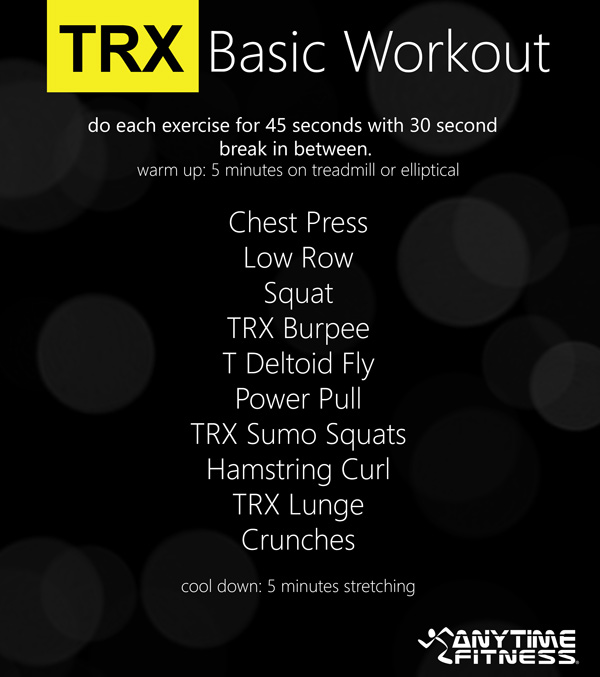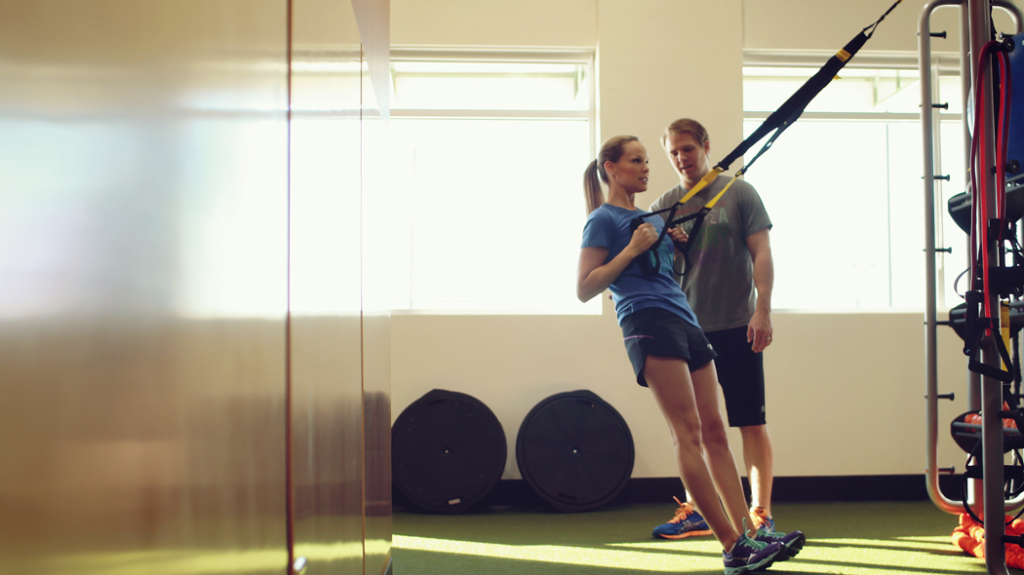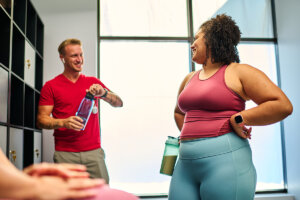Do you ever wonder to yourself, “What are all those yellow and black straps hanging from the ceiling?” Maybe you already know they’re part of a fitness phenomenon known as TRX…or the TRX Suspension Trainer, but you’ve never tried it. Either way, if you want to add some total body resistance exercises to your routine, TRX is the perfect place to get started.
What is TRX?
The TRX Suspension Trainer is a simple but brilliant full-body workout solution created by former Navy SEAL, Randy Hetrick. It consists of a set of straps from which you can perform all different types of resistance training exercises. TRX is especially effective in developing strength, balance, flexibility, movement, and stability, and has been described as “ALL core ALL the time.”
Why Should I Try It?
TRX is a unique training tool, because instead of working out on exercise machines or with hand-held weights, TRX works with the user’s body weight and gravity to accomplish a particular exercise move. Which means YOU hold the power. It’s strength training at its most personal and versatile.
Traditional training usually works on one muscle at a time and is done in a linear fashion, whereas suspension training allows you to move and contort your entire body into positions you never thought were possible, thus working multiple muscles and joints simultaneously. It improves your core stability, and also gets your heart rate going to provide a great cardiovascular workout.
Keep in mind that because you’re using your own body weight, and controlling the angles and movements yourself, this type of exercise is a great workout for all fitness levels.
NOTE: Please consult with your health care provider before beginning this or any other workout routine, especially if you have a history of heart disease or high blood pressure.
How often should I use TRX?
TRX is an entire body training system that’s the ultimate in functionality. You don’t have to worry about scheduling different body parts for different days and since the use of a TRX Suspension Trainer doesn’t require as much time, it’s easy to fit 10-20 minutes in daily. However, you will certainly see great results with 2 or 3 good TRX workouts a week, as well.
Bonus Option: Rip Training
While the TRX Suspension Training uses resistance straps, the TRX Rip Training uses a lever bar and resistance cord to provide a unique workout that focuses on speed, mobility, and rotation. Rip Training will challenge your body’s ability to control and resist rotation and replicates the same types of asymmetrical movements we use in everyday life (carrying groceries, performing athletic movements, picking up a child, etc).
Now that you are armed with the basics of TRX, you can give the system a try with this basic TRX workout!
TRX Suspension Basic Workout

Before you dive into these incredible TRX exercises, let’s get you warmed up with some cardio. Hop on a treadmill, stair climber, stationary bike, elliptical, or just run around the block for five minutes. Anything to get that engine revved, that blood pumping, and your muscles moving to prevent injury.
The recommended duration for each move is 45 seconds, unless you are a beginner, in which case, you might want to decrease that time to 30 seconds.
Off we go!
TRX Chest Press
Starting position: Stand with your legs at the width of your hips, grip the handles of the TRX straps and lean forward away from the TRX anchor point with your arms straight out from your shoulders in front of you. Then, bend at the elbows, keeping them tight at your sides, lowering your chest until your fists are just below your shoulders, then, push back to a straight arm position, picturing the muscles surrounding your shoulder blades engaging. Be mindful to move slowly to protect your shoulder girdles and prevent locking out your elbows. Do this for 45 seconds.
Low Row
Starting position: Take a strap in each hand, lean back away from the anchor point with arms extending from your shoulders, then walk your feet in while leaning back on your heels the entire time until your body is diagonal with your chest facing the sky. With your arms in a straight line in front of you, pull yourself toward the anchor point keeping your heels glued to the ground and your chest facing the sky, your arms tight at your sides until your fists are just below your shoulders. Unbend your elbows until your arms are in a straight line in front of you once again while pressing your shoulder blades down your back. Do this for 45 seconds. NOTE: Leaning back is how to work the middle back and upper arms. If you’d like to get at the rear deltoids, you can lean back less and pull the handles higher to affect more of a face pull, but face pulls need to be nuanced to be done correctly and are a bit more advanced.
TRX Squat
Let’s give the lower body some love. Pay close attention to your positioning here to protect your knees, low back, and balance. Starting position: Stand with your feet shoulder-width apart. Grab the hand cradles and move back away from the anchor point. The straps should be straight but not taught. Next raise your hands above your head and out into a Y shape, but keep your shoulders relaxed as much as possible. With your chest out and a strong core, bend your knees into a squat position. Once in the squat, move your legs and feet around a bit to get anchored, then slowly, on a 3 count, come back to a standing position. Your arms remain extended the entire time. Do this for 45 seconds.
TRX Burpee
This is NOT one of the easiest TRX exercises, so good form might be a challenge the first few times. Starting position: Place your right foot in the TRX foot cradles, then, slowly assume the plank position on the ground below the anchor point, but lower your chest all the way down to start. Then, like a traditional burpee, (with one leg) push off the ground with your hands below your shoulders and onto your left leg, hop up on your left leg, then bend your left knee as you head down into a pushup position. This one will challenge your core strength, lung capacity, and determination, so if you CAN do it for 45 seconds great, but you may need a few breaks. NOTE: Keep your core tight for each segment of the move to protect your lower back. Our goal is to keep you coming to the gym rather than the physical therapist. (Wink.)
T Deltoid Fly
Starting position: With your feet offset (right foot in front of your left foot) grasp the TRX handles and hold your arms straight out in front of you at the height of your shoulders and lean back. Lift yourself up by opening your arms directly out to each side to form a T at your shoulders. To make it more challenging step your feet forward for more lean and a further distance to travel with your chest from closed to open. You can also add challenge by bending at the waist and dropping your hips on the dip backwards. Keep your head up, looking forward at all times, and press your shoulder blades down. Do this for 45 seconds.
Power Pull
This is a pretty artistic upper body move. Adjust the TRX strap to its shortest length and place it into single hand mode. Starting position: With your feet hip width apart, grasp the handle with one hand, bend the elbow of that arm and keep it high as if you are shooting an arrow. Lean back and with your free arm out and straight, reach back while you rotate your upper body in the direction of your free hand away from the anchor point, while also straightening your bent elbow. You’ll complete the first part of the move with your free hand pointing behind you and your arms open at the height of your shoulders. To finish the move, reach your free hand back up to the anchor point, and re-bend the elbow of the arm grasping the strap. (This one will do wonders for your core stability.) Do this for 45 seconds.
TRX Sumo Squats
More low body building here, but slightly different than the squat move above. Your body position on this one will be different than the traditional squat-inspired TRX exercises. Starting position: Stand with your feet very wide, (wider than your shoulders), knees pointing slightly out. Grip the TRX handles at mid-chest and straighten your arms in front of you at the height of your shoulders. Squat deeply, allowing your arms to raise above your head. The straps will be taught at this point. Pull yourself back up to a standing position. Do this for 45 seconds. NOTE: If you don’t stand with your feet more than shoulder-width apart, you won’t work the correct muscles for the Sumo squat.
Hamstring Curl
There’s so much to love about this system, and this is one of the best TRX exercises to show you how versatile it is. Starting position: Lie on your back, hands at your sides, with your feet in the foot cradles under the anchor point. With your heels resting in the foot cradles, dorsi flex your feet toward you, then bend your knees, keeping them together, and pull them toward your hips. To increase the challenge, you can lift your hips off the ground anywhere from a slight incline all the way up to a bridge position keeping your hips in line with your shoulders as you bend your knees. In any of these scenarios, the bottom of the move is to bring your feet back under the anchor point. Do this for 45 seconds.
TRX Lunge
For this move you will again want to place the TRX handles into single grip mode, but this is one of the TRX exercises that has you placing your feet in the foot cradles. Starting position: Face away from the strap and step out a few paces from the anchor point, then place a foot in one of the foot cradles. Balance on a chair or have your coach give you a hand as you bend your free leg into a lunge, then back up. Be mindful not to hyperextend your knee. Stand straight keeping your chin up and shoulders back as you bend your knee directly above your ankle at the deepest point of the lunge. Do this for 45 seconds.
TRX Crunches
Starting position: Take a seat on the ground, place your feet in the foot cradles, then roll to your front. Come up on your hands into a plank position, being mindful not to lock out your elbows. With your hands directly below your shoulders, bend your knees, keeping them fairly close together as you pull them toward your chest for a crunch, then straighten back to plank position. Do this for 45 seconds. NOTE: If you’d like variations on the traditional TRX crunch, shift from plank position to frogger (crunch legs with knees wider than shoulder-width apart), then back to plank position and lift your hips high for pike, then back to plank position, moving back to regular crunch legs from plank position to complete the set. Do this for 45 seconds.



